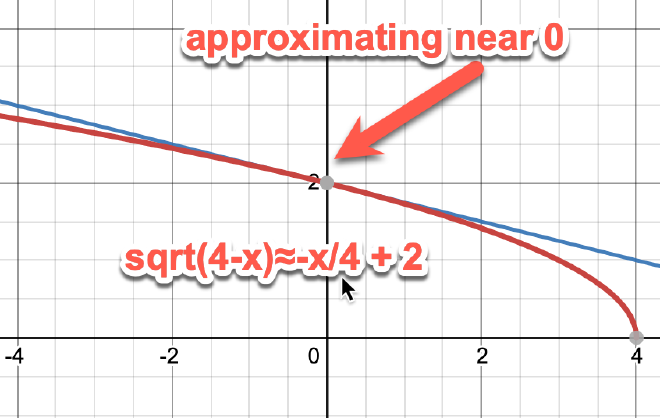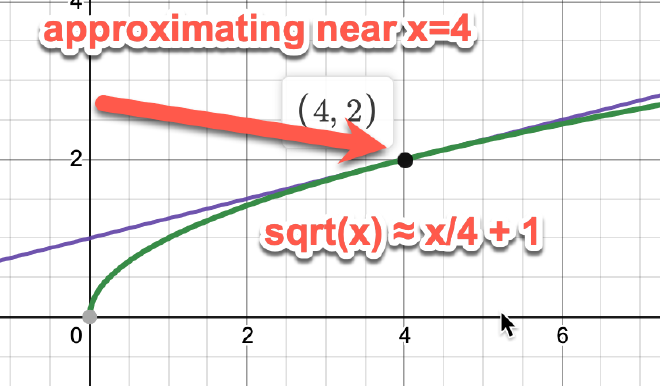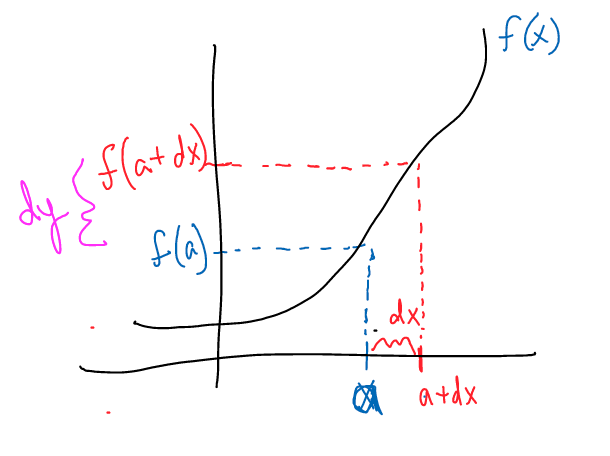Section 2.9
Table of Contents
Linear Approximations and Differentials
Linear Approximations #
The motivation for this section is that we will want to be approximating a function near a point by their tangent lines at that point.
Sample (very) basic example: #
We’re going to approximate $f(x) = x^2$ around $x=2$.
-
Find the tangent line at $x=2$
The derivative is $y = 2x$. The tangent line then is going to be: $\begin{align*} y-4 &= 4(x-2) \ y &= 4x - 4 \end{align*}$
-
Try to approximate (1.9)^2 using the tangent line:
Since 1.9 is “close” to 2, we can use the tangent line at 2:
$\begin{align*} y &= 4(1.9) - 4 \ &= 7.6 - 4 \ &= 3.6\end{align*}$
Since the actual value $(1.9)^2 = 3.61$, that’s pretty close. Not bad!
-
What about approximating $(1)^2$?
…. 1 is not “close” to 2.
$\begin{align*} y &= 4(1) - 4 \ &= 0\end{align*}$
and obviously $1^2 \ne 0$, so this is really crappy approximation.
Linear Approximations / Linearization #
In general, the tangent line to a function at the point $(a, f(a))$ is: $$ y - f(a) = f’(a) (x-a) $$
We’ll solve for $y$, label it $L(x)$, and give it the name linearization: $$ L(x) = f(a) + f’(a)(x-a) $$
Note This is called linearization, a linear approximation, or the first-order Taylor Polynomial1 for $f$ at $x=a$.
Example #
Approximate $y=\sin(x)$ for $x$ values near 0.
Since $$ f(x) \approx f(a) + f’(a) (x-a) $$
Find $a, f(a), f’(x),$ and $f’(a)$ to find the linear approximation.
Give it a try before revealing the solution here:
Click to reveal the answer.
a=0. And since $f'(x) = \cos x$, we have $f'(0) = 1$ and $f(0) = \sin(0) = 0$. So we have: $\begin{align*} L(x) &= f(a) + f'(a) (x-a) \\ &= 0 + 1(x-) \\ &= x \end{align*}$ So $\sin(x) \approx x$ when $x$ is near 0, with $x$ measured in radians.Now let’s use the approximation to approximate $\sin(1^\circ)$.
Click to reveal the answer.
Since $1^\circ = \pi/180 \approx 0.0175$, $\sin(1^\circ) = \sin(\pi/180) \approx \pi/180 \approx 0.0175$ Which is pretty good, since [$\sin(1^\circ)$](https://www.wolframalpha.com/input/?i=sin%281+degree%29) on the calculator is approximately 0.017452...Example #
- Find the linearization of $\sqrt[5]{32-4x}$ around $x=0$.
- Use that linearization to approximate $\sqrt{27.99}$
Example: #
Evaluating $\sqrt{3.99}$ in two ways, once, centering on $x=0$, and second, centering on $x=4$:
To approximate around $x=0$, we need the function that you’re using to approximate to be sqrt(4-x):
Here’s using the given function: #

and in order to get $\sqrt{3.99}$, you need to plug in $x=0.01$.
On the other hand, here’s using the function $\sqrt{x}$ around x=4. Notice that you’ll still get the same answers, but the $x$ values you’re using are very different

here to approximate $\sqrt{3.99}$ you need to plug in $x=3.99$.
Differentials #
Recall that $f’(x) = \dfrac{\text{ change in y’s }}{\text{change in x’s}}$
so $f’(x) \approx \dfrac{\Delta y}{\Delta x}$ and let $\Delta x \to 0$, we get Leibniz notation:
$$ f’(x) = \dfrac{dy}{dx} $$ and solving for $dy$ we get the differentials $$ dy = f’(x) dx $$
This defines the differential $dy$ in terms of the variables $x$ and $dx$.
Example #
If $f(x) = \sqrt{x+1}$, find $dy$.
Solution: (try it before revealing the spoiler)
Click to reveal the answer.
Since $f'(x) = \frac{1}{2\sqrt{x+1}}$ then $$ dy = f'(x) dx = \dfrac{dx}{2\sqrt{x+1}} $$Connection of differentials to linear approximations #

$$ f(a + dx) \approx f(a) + dy $$ a tiny, tiny change in $dx$ changes the function by the tiny, tiny change $dy$.
For concrete (less tiny) changes, we’ll write $\Delta x$ and $\Delta y$ to have:
$$ f(a + \Delta x) \approx f(a) + \Delta y $$
Example #
For example, using $f(x) = \sqrt{x+1}$, let $a=3$ and $\Delta x = 0.1$, find the approximation of $\sqrt{4.1}$
Solution: set up $$ \begin{align*} f(3 + \Delta x) &= f(3+0.1) \ &= f(3.1) \ &= \sqrt{3.1+1} \end{align*} $$ so $$ \begin{align*} f(3+\Delta x) = \sqrt{4.1} &\approx f(3) + \Delta y \ &\approx f(3) + \dfrac{\Delta x}{2\sqrt{3+1}} \ &= \sqrt{3+1} + \dfrac{0.1}{2\sqrt{3+1}} \ &= 2 + \dfrac{0.1}{4} \ &= 2.025 \end{align*} $$
… note that the calculator says $\sqrt{4.1} \approx 2.02484$, so we’re pretty close!
-
In calculus 2, we’ll be studying higher order Taylor Polynomials that are much better at approximating our values. ↩︎